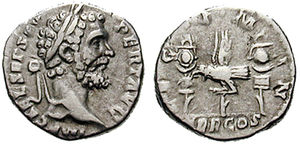
Legio I Minervia
Encyclopedia

Roman legion
A Roman legion normally indicates the basic ancient Roman army unit recruited specifically from Roman citizens. The organization of legions varied greatly over time but they were typically composed of perhaps 5,000 soldiers, divided into maniples and later into "cohorts"...
levied by emperor Domitian
Domitian
Domitian was Roman Emperor from 81 to 96. Domitian was the third and last emperor of the Flavian dynasty.Domitian's youth and early career were largely spent in the shadow of his brother Titus, who gained military renown during the First Jewish-Roman War...
in 82, for the campaign against the Germanic tribe of the Chatti
Chatti
The Chatti were an ancient Germanic tribe whose homeland was near the upper Weser. They settled in central and northern Hesse and southern Lower Saxony, along the upper reaches of the Weser River and in the valleys and mountains of the Eder, Fulda and Weser River regions, a district approximately...
. Its cognomen
Cognomen
The cognomen nōmen "name") was the third name of a citizen of Ancient Rome, under Roman naming conventions. The cognomen started as a nickname, but lost that purpose when it became hereditary. Hereditary cognomina were used to augment the second name in order to identify a particular branch within...
is related to the goddess Minerva
Minerva
Minerva was the Roman goddess whom Romans from the 2nd century BC onwards equated with the Greek goddess Athena. She was the virgin goddess of poetry, medicine, wisdom, commerce, weaving, crafts, magic...
, the legion's protector. There are still records of the I Minervia in the Rhine border in the middle of the 4th century. The legion's emblem is an image of goddess Minerva.
Legio I Minervia first, and main, camp was in the city of Bonna (modern Bonn
Bonn
Bonn is the 19th largest city in Germany. Located in the Cologne/Bonn Region, about 25 kilometres south of Cologne on the river Rhine in the State of North Rhine-Westphalia, it was the capital of West Germany from 1949 to 1990 and the official seat of government of united Germany from 1990 to 1999....
), in the province of Germania Inferior
Germania Inferior
Germania Inferior was a Roman province located on the left bank of the Rhine, in today's Luxembourg, southern Netherlands, parts of Belgium, and North Rhine-Westphalia left of the Rhine....
. In 89, they suppressed a revolt of the governor of Germania Superior
Germania Superior
Germania Superior , so called for the reason that it lay upstream of Germania Inferior, was a province of the Roman Empire. It comprised an area of western Switzerland, the French Jura and Alsace regions, and southwestern Germany...
. Due to this, Domitian gave them the cognomen Pia Fidelis Domitiana (loyal and faithful to Domitian) to acknowledge their support.
History
Between 101 and 106, the legion fought the Dacian Wars of emperor TrajanTrajan
Trajan , was Roman Emperor from 98 to 117 AD. Born into a non-patrician family in the province of Hispania Baetica, in Spain Trajan rose to prominence during the reign of emperor Domitian. Serving as a legatus legionis in Hispania Tarraconensis, in Spain, in 89 Trajan supported the emperor against...
, commanded by Hadrian
Hadrian
Hadrian , was Roman Emperor from 117 to 138. He is best known for building Hadrian's Wall, which marked the northern limit of Roman Britain. In Rome, he re-built the Pantheon and constructed the Temple of Venus and Roma. In addition to being emperor, Hadrian was a humanist and was philhellene in...
, the future emperor. The emblem with Minerva figure appears on the column of Trajan
Trajan's Column
Trajan's Column is a Roman triumphal column in Rome, Italy, which commemorates Roman emperor Trajan's victory in the Dacian Wars. It was probably constructed under the supervision of the architect Apollodorus of Damascus at the order of the Roman Senate. It is located in Trajan's Forum, built near...
in Rome
Rome
Rome is the capital of Italy and the country's largest and most populated city and comune, with over 2.7 million residents in . The city is located in the central-western portion of the Italian Peninsula, on the Tiber River within the Lazio region of Italy.Rome's history spans two and a half...
, along with symbols of other legions. After this war, I Minervia returned to its home city of Bonna. Together with XXX Ulpia Victrix
Legio XXX Ulpia Victrix
Legio trigesima Ulpia Victrix was a Roman legion levied by the Emperor Trajan in 100 for the Dacian Wars. The legion was active until disbandment of the Rhine frontier in the beginning of the 5th century. Their emblems were the gods Neptune and Jupiter and the Capricorn...
, stationed close by in Castra Vetera II (modern Xanten
Xanten
Xanten is a historic town in the North Rhine-Westphalia state of Germany, located in the district of Wesel.Xanten is known for the Archaeological Park or archaeological open air museum , its medieval picturesque city centre with Xanten Cathedral and many museums, its large man-made lake for...
), they worked in numerous military and building activities, even extracting stone from quarries.
Although it belonged to the Germanic army and Bonn was its camp, vexillatio
Vexillatio
A vexillatio was a detachment of a Roman legion formed as a temporary task force created by the Roman Army of the Principate. It was named from the standards carried by legionary detachments, vexillum , which bore the emblem and name of the parent legion...
nes (subunits) of the legion were allocated in different parts of the Empire:
- 162-166 war against the Parthian EmpireParthian EmpireThe Parthian Empire , also known as the Arsacid Empire , was a major Iranian political and cultural power in ancient Persia...
, commanded by emperor Lucius VerusLucius VerusLucius Verus , was Roman co-emperor with Marcus Aurelius, from 161 until his death.-Early life and career:Lucius Verus was the first born son to Avidia Plautia and Lucius Aelius Verus Caesar, the first adopted son and heir of Roman Emperor Hadrian . He was born and raised in Rome... - 166-175 and 178-180 war against the MarcomanniMarcomanniThe Marcomanni were a Germanic tribe, probably related to the Buri, Suebi or Suevi.-Origin:Scholars believe their name derives possibly from Proto-Germanic forms of "march" and "men"....
, commanded by emperor Marcus Aurelius - 173 campaign against the Chauci of Gallia BelgicaGallia BelgicaGallia Belgica was a Roman province located in what is now the southern part of the Netherlands, Belgium, Luxembourg, northeastern France, and western Germany. The indigenous population of Gallia Belgica, the Belgae, consisted of a mixture of Celtic and Germanic tribes...
, commanded by governor Didius JulianusDidius JulianusDidius Julianus , was Roman Emperor for three months during the year 193. He ascended the throne after buying it from the Praetorian Guard, who had assassinated his predecessor Pertinax. This led to the Roman Civil War of 193–197... - 198-211 garrison of the city of LugdunumLugdunumColonia Copia Claudia Augusta Lugdunum was an important Roman city in Gaul. The city was founded in 43 BC by Lucius Munatius Plancus. It served as the capital of the Roman province Gallia Lugdunensis. To 300 years after its foundation Lugdunum was the most important city to the west part of Roman...
, capital of Gallia
During the civil wars of the late 2nd and 3rd century, I Minervia supported the following emperors (each of them gave them the indicated titles, dropped out after their fall):
- Septimius SeverusSeptimius SeverusSeptimius Severus , also known as Severus, was Roman Emperor from 193 to 211. Severus was born in Leptis Magna in the province of Africa. As a young man he advanced through the customary succession of offices under the reigns of Marcus Aurelius and Commodus. Severus seized power after the death of...
- ElagabalusElagabalusElagabalus , also known as Heliogabalus, was Roman Emperor from 218 to 222. A member of the Severan Dynasty, he was Syrian on his mother's side, the son of Julia Soaemias and Sextus Varius Marcellus. Early in his youth he served as a priest of the god El-Gabal at his hometown, Emesa...
(Antoniniana) - Alexander SeverusAlexander SeverusSeverus Alexander was Roman Emperor from 222 to 235. Alexander was the last emperor of the Severan dynasty. He succeeded his cousin Elagabalus upon the latter's assassination in 222, and was ultimately assassinated himself, marking the epoch event for the Crisis of the Third Century — nearly fifty...
(Severiana Alexandriana) - the Gallic EmpireGallic EmpireThe Gallic Empire is the modern name for a breakaway realm that existed from 260 to 274. It originated during the Roman Empire's Crisis of the Third Century....
, that existed between 260 and 274
Around 353, Bonna was destroyed by the Franks, and I Minervia disappears from the sources. However, there is no reference to its destruction.
External links
- livius.org account for Legio I Minervia Legio I Minervia Pia Fidelis, German re-enactment group
- http://www.erste-legion.de/deutsch/main.php?main=historisch=LegioI, German re-enactment group, reenacting not only the Legio I Minervia.

